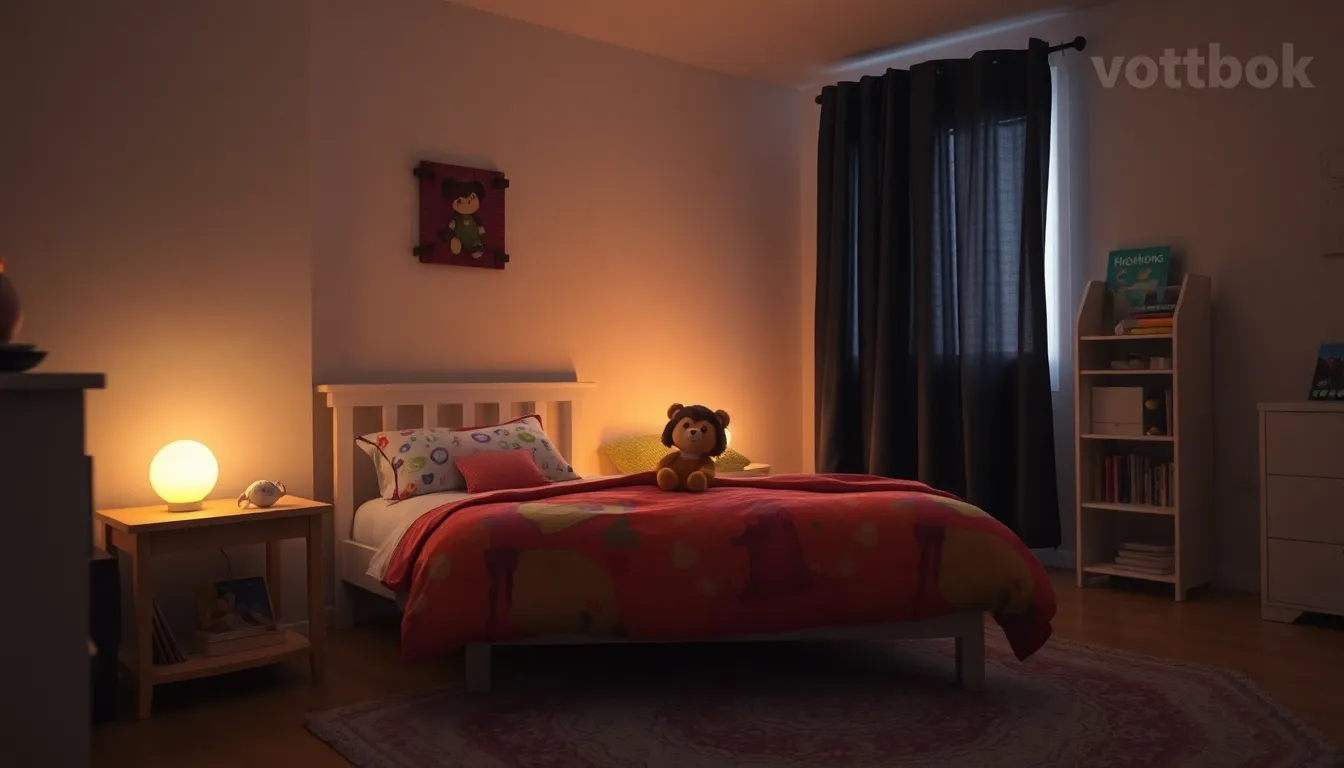Getting toddlers to sleep can feel like trying to herd cats on a caffeine high. Parents know the struggle all too well—one minute they’re wide awake, bouncing off the walls, and the next, they’re in a battle of wills over bedtime. But fear not! With a few clever tips, bedtime can transform from a chaotic circus into a peaceful slumber party.
Table of Contents
ToggleUnderstanding Toddler Sleep Patterns
Sleep patterns for toddlers can be complex. Parents often face unique challenges during this stage.
Common Sleep Challenges
Frequent awakenings disrupt nighttime rest. Toddlers may resist bedtime, expressing a desire to stay awake. Consistent nightmares sometimes lead to anxiety about sleeping alone. Some toddlers exhibit a preference for physical activity over rest, leading to overstimulation. Changes in routine, such as travel or family events, can also impact sleep quality.
Importance of Sleep for Toddlers
Sleep plays a vital role in toddler development. Adequate sleep supports growth and brain function, enhancing memory and learning. It fosters emotional regulation, helping toddlers manage feelings and improve behavior. Health experts emphasize that sleep deprivation can contribute to less effective immune systems. Prioritizing sleep ensures toddlers remain energized and ready to explore their environments.
Creating a Sleep-Friendly Environment

Establishing a conducive sleep environment plays a critical role in helping toddlers settle down. A few key elements can significantly enhance a child’s sleep quality.
Ideal Room Conditions
Maintain a cool temperature between 68°F and 72°F in the toddler’s room. Darkness promotes sleep, so using blackout curtains can help block outside light. Noise can disrupt sleep, so consider using white noise machines or soft lullabies to create a consistent sound backdrop. Additionally, ensuring a clutter-free space keeps distractions to a minimum. Fresh air circulation also matters; consider leaving windows slightly open or using air purifiers to create a healthier environment.
Bedding and Comfort Items
Choose a comfortable mattress that adequately supports your toddler’s growing body. Soft, breathable sheets made from cotton or bamboo enhance comfort and regulate body temperature. Include a favorite blanket or stuffed animal for added security and familiarity; these items often help toddlers transition to sleep. A lightweight sleeping bag or sleep sack can offer warmth without the risk of a loose blanket covering the child’s face. Regularly laundering bedding and comfort items maintains hygiene and promotes a fresher sleeping experience.
Establishing a Consistent Bedtime Routine
A consistent bedtime routine lays the groundwork for a peaceful transition to sleep. Setting predictable activities helps toddlers feel secure and ready for rest.
Steps for a Calming Pre-Sleep Routine
Start by dimming the lights in the evening. Engage in calming activities like reading books or taking a warm bath. Introduce quiet playtime to reduce energy levels. Follow this with snuggling or gentle conversations to foster emotional closeness. Gradually guide them to their sleeping area with a final comforting ritual. Use familiar sounds like lullabies or soft music to ease them into sleep.
Timing and Consistency
Bedtime should occur at the same time every night. Establishing a regular wake-up time during mornings also supports this routine. Parents can choose a time frame that accommodates daily schedules while ensuring at least 11 to 14 hours of sleep each night. Consistent rituals signal that it’s time to wind down, enhancing overall sleep quality. Adherence to this timing makes falling asleep easier for toddlers.
Encouraging Positive Sleep Associations
Fostering positive sleep associations can significantly enhance a toddler’s sleep experience. Parents can implement specific strategies to create comforting bedtime rituals.
Techniques for Sleep Independence
Encouraging toddlers to develop sleep independence builds their confidence. Offering a bedtime routine where they choose a story or select a comfort item promotes autonomy. Gradual steps towards self-soothing techniques can further empower them. Establishing a consistent sleep space cultivates familiarity and comfort. Parents can allow toddlers to practice going to bed alone while reassuring them of safety. Every step towards independence supports the child’s growth and sleep quality.
Managing Nighttime Fears
Addressing nighttime fears is essential for a peaceful sleep environment. Validating feelings helps toddlers understand that fears are common. Utilizing a nightlight can ease anxiety and provide a sense of security. Introducing calming rituals, such as reading a reassuring story, effectively distracts from fears. Empowering toddlers through positive dialogues about their fears fosters resilience. Maintaining a calm, consistent response to nighttime worries reassures them, promoting restful nights.
Tips to Help Toddlers Sleep Through the Night
Creating a conducive environment for toddlers to sleep through the night involves several strategies that focus on dietary habits and daytime activities.
Dietary Considerations
Foods can significantly influence a toddler’s sleep quality. Parents should aim to provide a balanced dinner rich in nutrients, avoiding heavy or spicy meals close to bedtime. Incorporating sleep-promoting foods like bananas, dairy products, or whole grains may help. Limiting sugary snacks or caffeinated beverages hours before bed helps prevent overstimulation. Additionally, maintaining a consistent eating schedule supports a toddler’s internal clock, making it easier for them to adapt to bedtime routines. Offering a small snack prior to sleep can ensure they are comfortable, but this should be light to avoid any digestive discomfort during the night.
Leveraging Daytime Activities
Active play during the day can promote better sleep at night. Engaging in physical activities helps expend energy, making toddlers more ready for rest later. Scheduling outdoor playtime for at least an hour allows them to soak up sunlight and engage in social interactions, which are vital for emotional development. Limiting screen time in the two hours leading up to bed supports relaxation. Quiet time activities like puzzle solving or coloring serve to calm them down as bedtime approaches. Building a structured daily routine with a balance of activity and rest enhances a toddler’s ability to settle into a peaceful sleep at night.
Helping toddlers sleep better is a journey that requires patience and understanding. By implementing the tips discussed, parents can create a nurturing environment that promotes restful nights. Establishing a consistent bedtime routine and encouraging positive sleep associations can significantly ease the transition to sleep.
Additionally, being mindful of dietary choices and daytime activities plays a crucial role in enhancing sleep quality. With these strategies in place, parents can transform bedtime from a chaotic struggle into a peaceful ritual. Ultimately, prioritizing sleep not only benefits toddlers but also fosters a harmonious household, allowing everyone to recharge for the adventures of the next day.



